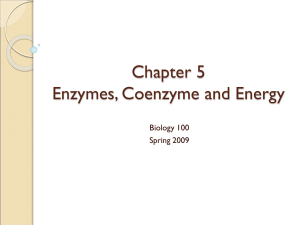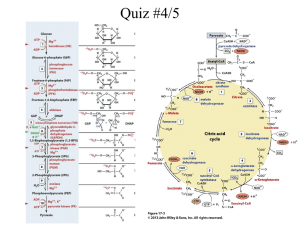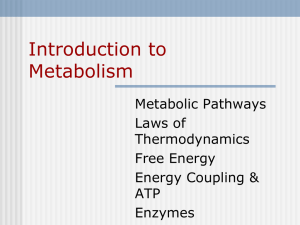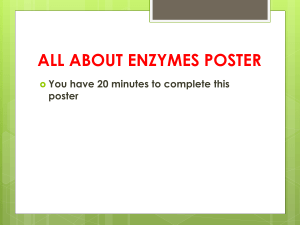Metabolic Pathways
advertisement
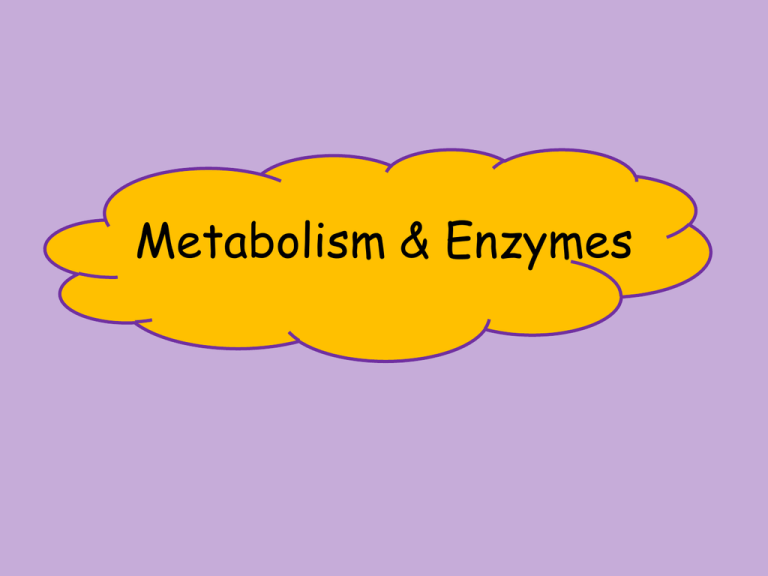
Metabolism & Enzymes What I should know • There are 2 types of metabolic pathwaysAnabolic and catabolic • the pathways - can have reversible and irreversible steps and alternative routes. Cell metabolism • Is the collective term for all the biochemical reactions that occur in a living cell • Reactions are turned on/off or sped up/slowed down according to the cell's immediate needs and overall functions • the numerous pathways involved in building up and breaking down cellular components must be monitored and balanced in a coordinated fashion • To do this, cells organise reactions into various enzyme-powered pathways Types of Metabolic Pathways • Metabolic pathways are chains of enzyme catalysed reactions in which the product of one reaction is the substrate for the next • In some cases these steps can be reversed, whereas others are irreversible • Anabolic & Catabolic Pathways • Reversible & Irreversible Pathways Anabolic Pathways • Synthesis reactions (building up) • Requires energy in the form of ATP to proceed • E.g. in DNA replication: DNA polymerase adds free nucleotides to the end of the newly-forming DNA, causing elongation (building up) of the new strand • E.g. Amino acids -----> Protein Catabolic Pathways • Breakdown reactions • Involves the release of energy to form ATP • E.g. Hydrogen peroxide (harmful) is broken down, by catalase in the liver, into Oxygen & water (harmless) • E.g. Proteins ---> amino acids Two types of metabolic pathways • Anabolic pathways require energy and are involved in the biosynthesis of complex molecules from simpler molecules • Catabolic pathways release energy and involve the breakdown of molecules Irreversible/Reversible Pathways • Glucose diffusing into a cell from a high conc outside to a low conc inside is irreversibly converted to intermediate 1 by enzyme A Glucose Enzyme A Intermediate 1 Enzyme B • Advantage: maintains a low conc of glucose inside the cell, promoting the entry of glucose Intermediate 2 Enzyme C Intermediate 3 Many enzymes Pyruvate Irreversible/Reversible Pathways • If more intermediate 2 is produced than is required, some can be converted back into intermediate 1, (reversible) • It can then be used in an alternative pathway • E.g. to build glycogen (in animals) or starch (in plants) • Alternative routes also allows steps in a pathway to be bypassed e.g. sorbitol • The reversible and irreversible steps allow this pathway to be kept under strict and precise control Glucose Enzyme A Intermediate 1 Enzyme B Intermediate 2 Enzyme C Intermediate 3 Many enzymes Pyruvate Do you know ? • There are 2 types of metabolic pathwaysAnabolic and catabolic • the pathways - can have reversible and irreversible steps and alternative routes. Control of Metabolic Pathways What you should know • Metabolic pathways are controlled by the presence or absence of particular enzymes in the metabolic pathway and through the regulation of the rate of reaction of key enzymes within the pathway. • Regulation can be controlled by intra- and extracellular signal molecules. • Induced fit and the role of the active site of enzymes including shape and substrate affinity. • How enzymes affect activation energy. • The effects of substrate and end product concentration on the direction and rate of enzyme reactions. • Enzymes often act in groups or as multi-enzyme complexes. • Control of metabolic pathways through competitive, noncompetitive and feedback inhibition Enzymes • Enzymes are biological catalysts which are essential to the maintenance of life • They form an enzyme-substrate complex that accelerates the rate of reaction • Molecules of a substrate have an ‘affinity’ (chemical attraction) for the enzyme’s active site Enzyme Properties • Enzymes are globular proteins • They possess a small region called the active site where the reaction occurs • Enzymes are specific in the reaction that they catalyse • Enzymes are only required in small amounts and remain unchanged at the end of the reaction Activation energy •The energy required to break chemical bonds in the reacting chemicals is called the activation energy •Enzymes lower the activation energy Induced Fit • Substrate molecule induces a slight change in the shape of the active site • This allows the substrate molecule to fit perfectly and change to its working conformation • The change in shape of the active site facilitates the reaction Metabolic Pathways and Enzymes • Some enzymes are associated with other enzymes involved in a particular pathway to form multi-enzyme complexes • In reality, DNA/RNA polymerase aren’t just single enzymes. • Rather, they are massive multienzyme complexes possessed of multiple catalytic activities Control by Enzymes • Metabolic reactions are controlled by the presence or absence of particular enzymes in metabolic pathways • If appropriate enzyme is present= reaction continues • If appropriate enzyme is absent= pathway stops Example of control by genes • Some organisms have the ability to turn on/off genes which code for enzyme production (called ‘enzyme induction’) • It is known to occur in humans, but the process is very complicated • A good example is E.Coli, a bacteria which have the ability to turn on/off a gene to produce an enzyme in order for them to undergo respiration • Please look at pages 86-87 of the TB and we’ll make notes on this example • Please copy Fig. 6.18 into your notes. • Underneath the diagram, make notes on the ‘Absence of Lactose’ and the ‘Presence of Lactose’ • What benefit is there to the E.Coli? The Effect of Substrate and End Product Concentration FACTORS AFFECTING ENZYME ACTIVITY • • • • • Temperature pH substrate concentration enzyme concentration inhibitors INCREASING SUBSTRATE CONCENTRATION • Increasing substrate conc increases rate of reaction as more active sites become occupied • This continues until all of the active sites become occupied • further increases in substrate conc make no difference to the rate of the reaction thereafter • If displayed on a graph, the line would increase, to a point, where it would then level off * See also fig. 6.12 in TB Intra/Extracellular Signals - Intracellular signal molecules are those that effect the cell’s metabolism & originate from within the cell - Extracellular signal molecules effect the cell’s metabolism, but come from the cell’s environment Regulating Enzyme activity A cell has to control enzyme activity. It does this by: • Controlling number of enzyme molecules in cell • Keeping reactions (and enzymes) in compartments eg. Mitochondria or lysosome. • Changing enzyme shape (most effective) Enzyme activity • Enzymes are always present due to constant expression. This means they need to be controlled. • Enzymes can be inhibited by other things binding to them Competitive and Non-competitive Inhibition Inhibition •Competitive – A molecule with similar molecular shape to the substrate competes for the active site and reduces the concentration of available enzyme •Noncompetitive – A molecule binds to the enzyme at another site; it changes the conformation of the enzyme and its active site. Thus, catalytic efficiency is reduced. Control of a Pathway using its enzymes • Metabolic pathways can be controlled by the switching on or off of the first enzyme in the pathway • If the first enzyme is switched off the rest of the pathway stops due to the lack of intermediates • The first enzyme can be inhibited by high levels of the final product from the pathway End-Product Inhibition • Used in the control of metabolic pathways • The end-product of the pathway inhibits the activity of the first enzyme in the pathway • This is energetically efficient as it avoids the excessive production of the intermediates of a pathway Do you know ? • Metabolic pathways are controlled by the presence or absence of particular enzymes in the metabolic pathway and through the regulation of the rate of reaction of key enzymes within the pathway. • Regulation can be controlled by intra- and extracellular signal molecules. • Induced fit and the role of the active site of enzymes including shape and substrate affinity. • How enzymes affect activation energy. • The effects of substrate and end product concentration on the direction and rate of enzyme reactions. • Enzymes often act in groups or as multi-enzyme complexes. • Control of metabolic pathways through competitive, noncompetitive and feedback inhibition


